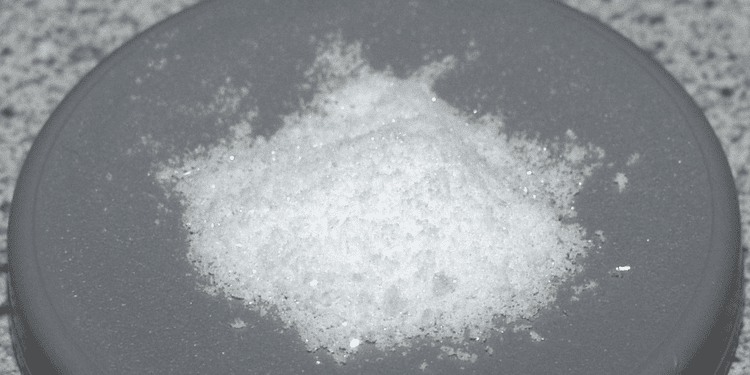Molar mass 148.157 g/mol | ||
 | ||
Appearance White crystalline solid | ||
Acetone peroxide is an organic peroxide and a primary high explosive. It is produced by the oxidation of acetone to yield a mixture of linear monomer and cyclic dimer, trimer, and tetramer forms. The trimer is known as triacetone triperoxide (TATP) or tri-cyclic acetone peroxide (TCAP). Acetone peroxide takes the form of a white crystalline powder with a distinctive bleach-like odor and can explode if subjected to heat, friction, or shock. As a non-nitrogenous explosive, TATP has historically been more difficult to detect, and it has been implicated as the explosive used in terrorist attacks in Europe (2016 Brussels bombings) in 2016 and earlier.
Contents
- Acetone peroxide explosion montage
- History
- Chemistry
- Industrial uses
- Use in improvised explosive devices
- References
Acetone peroxide explosion montage
History
Acetone peroxide (specifically, triacetone triperoxide) was discovered in 1895 by Richard Wolffenstein. Wolffenstein combined acetone and hydrogen peroxide, and then he allowed the mixture to stand for a week at room temperature, during which time a small quantity of crystals precipitated, which had a melting point of 97 °C. He was the first researcher to receive a patent for using the peroxide as an explosive compound.
In 1899 Adolf von Baeyer and Victor Villiger described the first synthesis of the dimer and described use of acids for the synthesis of both peroxides. Baeyer and Villiger prepared the dimer by combining potassium persulfate in diethyl ether with acetone, under cooling. After separating the ether layer, the product was purified and found to melt at 132–133°C. They found that the trimer could be prepared by adding hydrochloric acid to a chilled mixture of acetone and hydrogen peroxide. By using the depression of freezing points to determine the molecular weights of the compounds, they also determined that the form of acetone peroxide that they had prepared via potassium persulfate was a dimer, whereas the acetone peroxide that had been prepared via hydrochloric acid was a trimer, like Wolffenstein's compound.
Work on this methodology and on the various products obtained, was further investigated in the mid-20th century by Milas and Golubović.
Chemistry
The chemical name acetone peroxide is most commonly used to refer to the cyclic trimer, obtained by a reaction between hydrogen peroxide and acetone in an acid-catalyzed nucleophilic addition, although various further monomeric and dimeric forms are possible.
Specifically, two dimers, one cyclic (C6H12O4) and one open chain (C6H14O4), as well as an open chain monomer (C3H8O4), can also be formed; under a particular set of conditions of reagent and acid catalyst concentration, the cyclic trimer is the primary product. A tetrameric form has also been described, under different catalytic conditions. Under neutral conditions, the reaction is reported to produce the monomeric organic peroxide.
Organic peroxides in general are sensitive, dangerous explosives, and all forms of acetone peroxide are sensitive to initiation. TATP decomposes explosively; examination of the explosive decomposition of TATP predicts "formation of acetone and ozone as the main decomposition products and not the intuitively expected oxidation products." Very little heat is created by the explosive decomposition of TATP; the foregoing computational analysis suggests that TATP decomposition as an entropic explosion. However, this hypothesis has been challenged as not conforming to actual measurements. The tetrameric form of acetone peroxide, prepared under neutral conditions using a tin catalyst in the presence of a chelator or general inhibitor of radical chemistry, is reported to be more chemically stable, although still a very dangerous primary explosive.
Some forms of acetone peroxide are prone to loss by sublimation and evaporation.
Several methods can be used for trace analysis of TATP, including gas chromatography/mass spectrometry (GC/MS) high performance liquid chromatography/mass spectrometry (HPLC/MS), and HPLC with post-column derivitization.
Industrial uses
Ketone peroxides, including acetone peroxide and methyl ethyl ketone peroxide, find application as initiators for polymerization reactions, e.g., silicone or polyester resins, in the making of fiberglass-reinforced composites. For these uses, the peroxides are typically in the form of a dilute solution in an organic solvent; methyl ethyl ketone is more common for this purpose, as it is stable in storage.
Acetone peroxides are common and unwanted by-products of oxidation reactions, such as those used in phenol syntheses.
Acetone peroxide is used as a flour bleaching agent to bleach and "mature" flour.
Due to their explosive nature, their presence in chemical processes creates potential hazardous situations. Numerous methods are used to reduce their appearance as byproducts—for instance, shifting pH to more alkaline, adjusting reaction temperature, or adding inhibitors of their production.
Use in improvised explosive devices
TATP and the other explosive forms of acetone peroxide belong to the few high explosives that do not contain nitrogen, and so can pass undetected through explosive detection scanners designed to detect nitrogenous explosives. Because of its high susceptibility to accidental detonation (and resulting "workplace accidents" in bomb-making shops), TATP has been referred to as the "Mother of Satan." It is used by terrorists for its ability to evade detection aimed at nitrogenous explosives, and due to its low cost and the ease with which its precursors can be obtained. It has been described in popular media as easily prepared from readily available retail ingredients, such as hair bleach and nail polish remover.
As such, TATP has been used in bomb and suicide attacks and in improvised explosive devices, including the London bombings on 7 July 2005, where four suicide bombers killed 52 people and injured more than 700. It was one of the explosives used by the "shoe bomber" Richard Reid and was used by the suicide bombers in the November 2015 Paris attacks and 2016 Brussels bombings.
